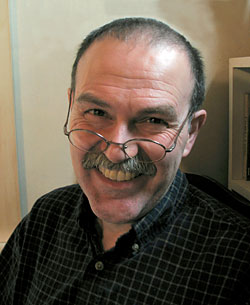Are You Drowning Your Story in Your Imagery?
By Dave King | March 15, 2022 |
 Purple prose, it’s the bane of a writer’s existence. Like a noisome stench pulled from the depths of perdition, it infects their prose, tearing at the very fiber of literary excellence, rending joint from sinew —
Purple prose, it’s the bane of a writer’s existence. Like a noisome stench pulled from the depths of perdition, it infects their prose, tearing at the very fiber of literary excellence, rending joint from sinew —
Um . . . sorry.
Purple prose, meaning writing so overblown that it interferes with the storytelling, has evidently been a problem for a long time. We first heard the term in Horace’s Poetic Arts, written more than 2000 years ago.
Weighty openings and grand declarations often
Have one or two purple patches tacked on, that gleam
Far and wide, when Diana’s grove and her altar,
The winding stream hastening through lovely fields,
Or the river Rhine, or the rainbow’s being described.
There’s no place for them here. Perhaps you know how
To draw a cypress tree: so what, if you’ve been given
Money to paint a sailor plunging from a shipwreck
In despair?
Last month, I cut some of the purple out of a passage from Elizabeth George’s latest mystery, Something to Hide. One commenter complained that I was draining the writing of some of its richness out of a misplaced need to jump into the story more quickly. The commenter mentioned paint-by-number art.
But prose doesn’t turn purple as soon as it begins to dwell on evocative details or use complex language. In fact, some of the writers I enjoy most – John Crowley, Mark Halperin, William Faulkner – could not be accused of being minimalist. And Ms. George, in her earlier novels, wrote with richly drawn characters, but much greater simplicity of style.
Writing is pushed into the purple zone when the style starts to get in the way of the story. In the Elizabeth George example, she had said just before the edited passage that the viewpoint character was distracted, thinking about his girlfriend. She then went on to describe the view around him in painstaking, sometimes repetitive, detail. Taken in isolation, the description wasn’t awful, but it didn’t fit the moment or the character. The description became an end in itself, and the story was sidelined.
Purple prose is often, though not always, self-conscious. If you’re ignoring your story to indulge your own descriptive talents, you do tend to focus on yourself. The strain often shows. I think I first realized this when I was in college, reading the first of the Sword of Shannara books. For those of you unfamiliar, this is a series of fantasy novels by Terry Brooks following the path blazed by Tolkien. The thing that offended my nascent editorial sensibilities was passages like this one:
In the midst of the chilling cries, with a low rumble that sounded from the heart of the earth, the Hadeshorn opened at its center in the manner of a thrashing whirlpool and from out of its murky waters rose the shroud of an old man, bowed with age. The figure rose to full height and appeared to stand on the waters themselves, the tall, thin body a transparent gray of ghostlike hue that shimmered like the lake beneath it. Flick [the point of view character] turned completely white. The appearance of this final horror only confirmed his belief that their last moments on earth were at hand.
Here Flick would certainly be paying attention – Brooks isn’t ignoring his characters. But it’s hard to imagine Flick would describe what was happening in quite the terms Brooks uses. If he’s in fear for his life, would he really recognize that his beliefs were confirmed by an appearance with a ghostlike hue?
Compare this to a passage from the actual Tolkien, of the appearance of the Balrog from The Fellowship of the Ring
But it was not the trolls that had filled the Elf with terror. The ranks of the orcs had opened, and they crowded away, as if they themselves were afraid. Something was coming up behind them. What it was could not be seen: it was like a great shadow, in the middle of which was a dark form, of man-shape maybe, yet greater; and a power and terror seemed to be in it and to go before it.
The language is certainly formal – “to be in it and to go before it” is not a construction that comes up in everyday conversation. But it doesn’t feel as stilted as Brooks. After all, Tolkien was a philologist, steeped in the rigorous language of academia and early- and middle-English texts, which have a very different rhythm to them. Elaborate structures came naturally to him, and so his language flows more naturally for readers.
One final caveat – some readers do read fiction primarily for the striking and original use of language, whether it interferes with the story or not. They read prose for the same reason people read poetry — after all, you don’t read Elliot to find out what happened to J. Alfred Prufrock. Well, De gustibus non est disputandum (“There’s no arguing over tastes”) predates even Horace and still makes good sense.
Speaking personally, I can appreciate beautiful prose. But beautiful prose that serves a storytelling purpose is what really does the job.
What are your favorite examples of purple prose — points for a Bulwer-Lytton other than Clifford Irving (i.e. “It was a dark and stormy night.”) How did they go wrong? What strengths were lying there under the verbiage?
[coffee]










Hi Dave. Love your post today. Do you consider this passage purple prose, if so why or why not? If this appeared in a manuscript, would you edit this for today’s readers?
‘Folds of scarlet drapery shut in my view to the right hand; to the left were the clear panes of glass, protecting, but not separating me from the drear November day. At intervals, while turning over the leaves of my book, I studied the aspect of that winter afternoon. Afar, it offered a pale blank of mist and cloud; near a scene of wet lawn and storm-beat shrub, with ceaseless rain sweeping away wildly before a long and lamentable blast.’
I actually like this paragraph because it’s so evocative. The paragraph is from Charlotte Bronte’s opening chapter in Jane Eyre. Your thoughts? I confess to being a fan of the Bronte sisters and I do like to read 19th-century fiction.
Hey, Paula,
I agree with you — the paragraph is not purple. The observations are all tightly tied to the character, and they are given in a language she would use. They are delightfully concrete — the scarlet drapery, the clear glass, the storm-beat shrubs. They also don’t get in the way of the story. Instead, they set the quiet, withdrawn mood that, if I remember correctly, is broken in the next couple of paragraphs when the daughters of the house (was it?) come hunting for Jane. That conflict is what triggers the action of the book.
Flowery writing is almost never good, but to what degree should an author use word magic? For some readers a single simile is too much; for others plain prose is a bore.
The answer, I believe, is another question: What will most excite the reader’s imagination? What will cause the reader to no only “see” the story but feel it? Even more, what will cause the reader to participate, so immersed that it seems that the reader is no longer sitting in his or her reading chair but living in the story too?
I find that the some types of story do not benefit from very many wordly flourishes; others are flat without them. In general, though, it is the strength and clarity of the prose that works.
Word magic isn’t limited to only imagery, either. There is a vast range of rhetorical tricks and literary devices available. For the most part, I wish that once in a while writers would use a more of them.
But that’s me.
Good, thought provoking comments. And I’m liking “word magic.” I was looking for an evocative way to describe the kind of prose I was talking about.
And you’re right that this kind of word magic doesn’t fit all sorts of stories or all tastes. In fact, there are probably some good satires to be had writing, for instance, a noir thriller in the style of Jane Austen. It is a matter of fitting the style to your story so as to best excite your readers’ imaginations.
Dave:
I myself am prone to purple prose. As a remedy, I remind myself that writing is like fixing dinner for guests: they won’t know about the elaborate meal you didn’t serve them. Just make sure they’re happy and satisfied with what you put on their plates.
There’s also the possibility of recycling. Even if they don’t fit your current work in progress, all those insightful descriptions and original metaphors can find a home elsewhere.
While Mr. King’s edit of Ms. George’s “Something to Hide” was technically proficient, it ignored context. And because it ignored context the edit rendered the passage lifeless. Editing can be and often is subjective. Some say tomayto, some say tomahto. I won’t pummel a deceased equine, but I’ll stand by my comment.